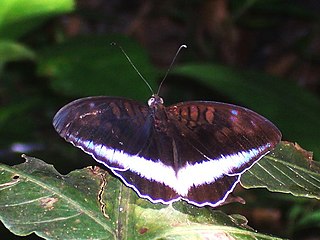
The Limenitidinae are a subfamily of butterflies that includes the admirals and relatives. The common names of many species and genera reference military ranks or – namely the Adoliadini – titles of nobility, in reference to these butterflies' large size, bold patterns, and dashing flight. In particular, the light stripe running lengthwise across the wings of many Limenitidini has reminded earlier authors of officers' shoulder marks and epaulets.

Adelpha californica, the California sister, is a species of butterfly in the family Nymphalidae. They are common in California, but can also be found in western Nevada and Oregon, as well as in northern Baja California. The upper surfaces of their wings are dark brown to black with wide cream white bands dissecting both wings and two orange patches near the tips of the forewings. The underside is variously colored with browns, blue, orange, and white. A. californica is unpalatable to predators and is part of a large mimicry complex.

Adelpha fessonia, the band-celled sister or Mexican sister, is a species of butterfly of the family Nymphalidae. It is found in Panama north through Central America to Mexico. It is a periodic resident in the lower Rio Grande Valley, Texas.

Adelpha is a genus of brush-footed butterflies found from the southern United States and Mexico to South America. They are commonly known as sisters, due to the white markings on their wings, which resemble a nun's habit. This genus is sometimes included with the admiral butterflies (Limenitis).

Adelpha bredowii, the Bredow's sister, is a species of butterfly in the family Nymphalidae. It is endemic to western, central, and southern Mexico. Adelpha bredowii belongs to the serpa species group in the genus Adelpha (sisters). Adelpha bredowii previously included two subspecies, the California sister and the Arizona sister. Recent phylogenetic studies, however, conclude that morphological, geographical, and genetic evidence make it clear that these are correctly separate species. They have been reclassified as the species Adelpha californica and Adelpha eulalia, respectively.
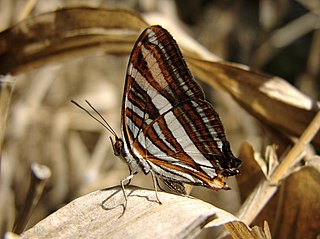
Adelpha syma, the Syma sister, is a species of butterfly of the family Nymphalidae. It is found in South America, including Paraguay, Argentina and Brazil.

Adelpha mesentina, the mesentina sister, is a species of butterfly of the family Nymphalidae. It is found in the eastern Andes from Venezuela to Bolivia and also on the Guiana Shield and throughout the central and western Amazon basin.
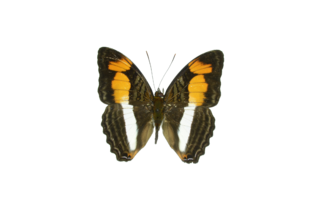
Adelpha melona, the Melona sister, is a species of butterfly of the family Nymphalidae. It is found in Central and South America.

Adelpha lycorias, the pink-banded sister, is a species of butterfly of the family Nymphalidae.

Adelpha plesaure, the pleasure sister, is a species of butterfly of the family Nymphalidae.

Adelpha alala, the Alala sister, is a species of butterfly of the family Nymphalidae. It is found in South America.
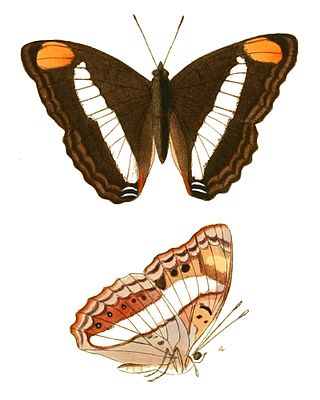
Doxocopa pavon, the Pavon emperor or Pavon, is a species of butterfly in the family Nymphalidae. They can be found from Paraguay in South America up to Texas in the southern United States. They are generally brown in their overall coloration, with two bands of white straddling the middle of the upper surfaces of the wings, and a patch of orange on the tips of their forewings. The upper surfaces of the wings of the males are overlaid by an iridescent blue-purple sheen. The females of the species closely resemble members of the unrelated genus Adelpha.
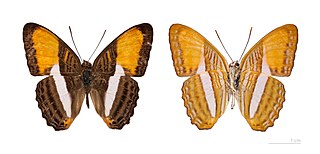
Adelpha cytherea, the smooth-banded sister, is a species of butterfly of the family Nymphalidae. It is found in the Central and South America.

Adelpha boreas, the gaudy sister or solitary sister, is a butterfly of the family Nymphalidae. It was described by Arthur Gardiner Butler in 1866. It is found from Costa Rica to Bolivia. The habitat consists of primary and disturbed rainforests and cloudforests at altitudes between 200 and 1,200 meters.
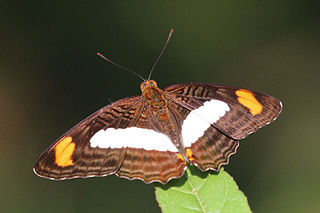
Adelpha iphiclus, the Iphiclus sister, is a butterfly of the family Nymphalidae. It was described by Carl Linnaeus in his 1758 10th edition of Systema Naturae. It is found in the tropics and sub-tropics of Central and South America, from Mexico to Bolivia. The habitat consists of disturbed areas in deciduous and evergreen forests at altitudes ranging from 0 to 1,200 meters.
Adelpha nea, the Nea sister, is a butterfly of the family Nymphalidae. It was described by William Chapman Hewitson in 1847. It is found from south-eastern Mexico, Belize and Costa Rica to Venezuela and southern Peru, the Guianas and Amazonian Brazil.

Adelpha erotia, the Erotia sister, is a butterfly of the family Nymphalidae. It was described by William Chapman Hewitson in 1847.
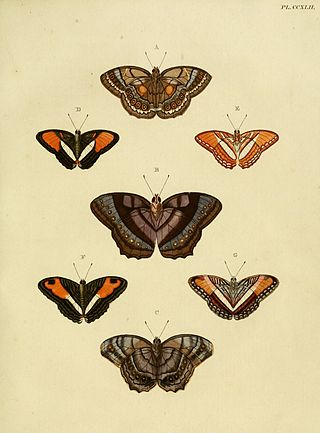
Adelpha cocala, the cocala sister or orange-washed sister, is a butterfly of the family Nymphalidae. It was described by Pieter Cramer in 1779. It is found from Honduras to Panama, Guatemala, Venezuela, Colombia, Suriname, Peru, Bolivia and Brazil.

Adelpha serpa, the celerio sister, is a butterfly of the family Nymphalidae. It was described by Jean Baptiste Boisduval in 1836. It is found from Mexico to Brazil. The habitat consists of rainforests and cloudforests at elevations ranging from 300 to 2,000 meters.

Adelpha basiloides, the spot-celled sister, is a species of admirals, sisters in the family of butterflies known as Nymphalidae. It is found in North and Central America.



















